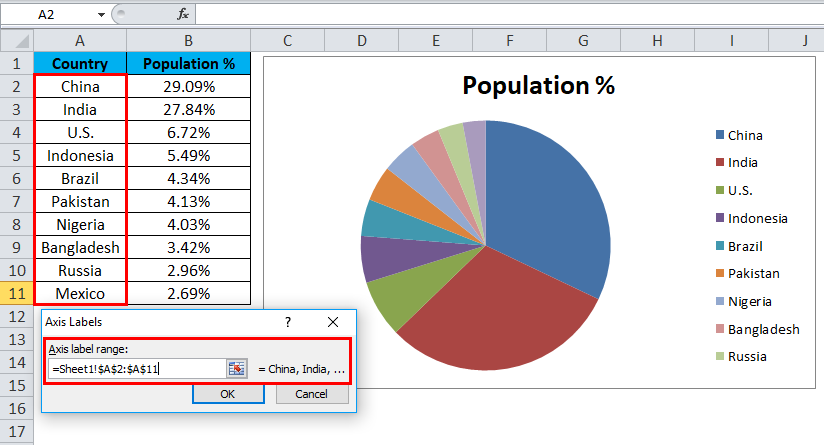
- HOW TO MAKE A PIE CHART IN EXCEL WITH MULTIPLE LABELS UPDATE
- HOW TO MAKE A PIE CHART IN EXCEL WITH MULTIPLE LABELS SERIES
Uncheck the Show a zero in cells that have zero value option (as shown in Figure C). In the Display options for this worksheet section, choose the appropriate sheet from the drop-down menu. In Excel 2003, choose Options from the Tools menu and skip to #3. In Excel 2007, click the Office button and then click Excel options. Click the File tab and choose Options. You can hide the 0s by unchecking the worksheet display option called Show a zero in cells that have zero value. Neither line chart handles the missing 0s well, as you can see in Figure B (if you removed the 0 values in the sheet, re-enter them before you continue). The pie chart doesn’t chart the missing 0s, but the legend still displays the category label. The stacked bar responds well to this solution. Unfortunately, this simplest approach doesn’t always work as expected. You might try removing the 0 value altogether if it’s a literal 0 and not the result of a formula. Some will work with limited results, and some won’t work at all - but ahead and try them. Now that you’re familiar with the example data, let’s review a few methods for suppressing the 0 values in our example charts. The other two charts have three data series: Vendor 1, Vendor 2, and Vendor 3. The pie and single line charts reflect the data in column B for Vendor 1. Simply close the file and reopen without saving. If you work through the instructions with the example workbook, be sure to undo each solution before you start the next. Your results might vary, depending on your version of Excel and your chart defaults. LEARN MORE: Office 365 Consumer pricing and features About the example dataįigure A shows the data and initial charts that we’ll use throughout this article. We’ll review a few that offer quick but limited results with minimum effort. When you don’t want to display these values, you have a few choices, and some work better than others. Your data and the chart’s purpose will guide you in this decision. The steps are similar to what Susan Harkins describes in the following tutorial.Ĭharting 0s isn’t wrong, but you won’t always want to display them in your Excel charts. For this demo, he uses Microsoft Office 365. Right-click on one section of the secondary chart, click Format Data Point…, click Fill, then click No Fill from the color drop down.Editor’s note: In the video, Brandon Vigliarolo walks you through a couple of ways for suppressing 0 values in Excel charts. 
HOW TO MAKE A PIE CHART IN EXCEL WITH MULTIPLE LABELS SERIES
To do this easily, enter data into Excel but combine the desired numerical values into a single row and name the categorical value “other.”Įnter data into Excel with the desired numerical values at the end of the list.ĭouble-click the primary chart to open the Format Data Series window.Ĭlick Options and adjust the value for Second plot contains the last to match the number of categories you want in the “other” category. There are two ways to combine a number of small categories into one “other” category.
HOW TO MAKE A PIE CHART IN EXCEL WITH MULTIPLE LABELS UPDATE
smallest to largest), sort the original data using Excel’s sorting tool, and the chart will automatically update group the chart slices by size.Ĭombining Small Slices into an “Other” Category If you want to position the slices based on size (e.g. You can create new categories, sort how the slices appear, and add WordArt. There are a variety of ways to customize a pie chart. WorkApps Package your entire business program or project into a WorkApp in minutes.Digital asset management Manage and distribute assets, and see how they perform.Resource management Find the best project team and forecast resourcing needs.Intelligent workflows Automate business processes across systems.Governance & administration Configure and manage global controls and settings.Streamlined business apps Build easy-to-navigate business apps in minutes.Integrations Work smarter and more efficiently by sharing information across platforms.

Secure request management Streamline requests, process ticketing, and more.Process management at scale Deliver consistent projects and processes at scale.Content management Organize, manage, and review content production.

Workflow automation Quickly automate repetitive tasks and processes. Team collaboration Connect everyone on one collaborative platform. Smartsheet platform Learn how the Smartsheet platform for dynamic work offers a robust set of capabilities to empower everyone to manage projects, automate workflows, and rapidly build solutions at scale.







 0 kommentar(er)
0 kommentar(er)
